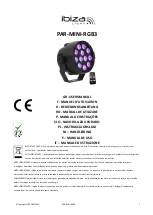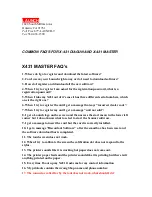
15
4.
Push the yellow CHARGE button to start charging the internal high voltage capacitor and wait until the front
meter reaches value set on Steps 1 or 2. Verify that the red TRIGGER indicator is now lit.
5.
Once the desired voltage is reached, press the red
TRIGGER
button to deliver the high voltage pulse (be
sure not to touch the output and return leads when pressing the trigger switch).
6.
Turn the rear-panel Power Switch OFF.
Pulse Verification Procedure
The following procedure will verify that the high voltage pulse is properly generated by the D5-PF tester. We
recommend that this procedure be conducted periodically to ensure proper operation of the tester.
The following items are needed to conduct this procedure:
-
High voltage oscilloscope probe (1000:1)
-
Digital Oscilloscope
Always ensure that the measuring instruments are rated for the voltage and frequency response involved. A digital
oscilloscope or probe with a low frequency response will result in erroneous readings that could be misread.
CAUTION
High voltage generated by the MegaPulse tester is exposed during this test. A risk of shock exists.
Exercise care when using the MegaPulse tester.
1.
Turn the rear-panel Power Switch OFF.
2.
Set Aux output switch to “Return” position.
3.
Set S3 to “Open” position.
4.
If the MegaPulse includes option 100X, install the 100X jumper on the rear panel.
5.
If the MegaPulse includes option 34, set the Trigger time switch to 200mS, install the 50k ohm jumper on
the front panel.
6.
Disconnect all high voltage cables from the outputs (50 ohm, 400 ohm, Energy Measurement Point and 50k
ohm if included).
7.
Turn the rear-panel Power Switch ON. If residual voltage is shown on LED display:
a.
Press the red
TRIGGER
button to discharge the main capacitor into the internal resistor of the
MegaPulse unit.
8.
Set the Voltage Set Point to 5000V, see section “Voltage Set Point Adjustment.”
9.
Select the internal inductance of 500uH by using the front panel switch “INDUCTOR.”
10.
Plug the high voltage test lead (black) into the Return jack, located on the front panel.
11.
Plug the high voltage test lead (red) into the 50 ohm jack, located on the front panel.
12.
Connect the ends of the test leads to the measuring instrument. See Figure 4 for an example.
13.
Set the next capturing setting on the digital oscilloscope to capture the high voltage pulse:
a.
Vertical Scale = 1.00KV / div.
b.
Horizontal Scale = 500uS / div
c.
Trigger Level = + 1kV
d.
Slope transition “Low to High.”
e.
Set “High Frequency Reject” mode.
f.
Set “Single Pulse” capture mode.
14.
Press the Charge button and wait until voltage reaches 5000V.
15.
Press the Trigger button to deliver the pulse (be sure not to touch the output and return leads when pressing
the trigger switch).
16.
Verify the amplitude of the positive pulse captured on the digital oscilloscope:
a.
Vpeak about 4.72KV, see figure 5 (When selected inductor is 500uH).
b.
Vpeak about 3.88KV, see figure 6 (When selected inductor is 25mH).
17.
Select a negative pulse by pressing the polarity button, and verify the yellow REV indicator is lit.
18.
Change the capturing setting on the digital oscilloscope to capture the negative pulse:
Summary of Contents for MegaPulse D5-PF
Page 1: ......
Page 2: ......
Page 5: ...iii Cleaning 26 Calibration Information 26 Technical Assistance 27...
Page 6: ...iv...
Page 16: ...10 Figure 2 Controls Indicators Connectors MegaPulse D5 PF Rear Panel...
Page 23: ...17 Figure 7 Y1 Y2 Test Output...













































